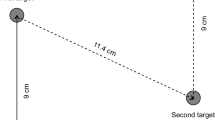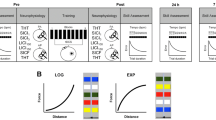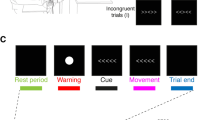Abstract
Age-related declines in central processing may affect corticospinal (CS) excitability that underlies the emergence of voluntary responses to external stimuli. We used single-pulse transcranial magnetic stimulation (TMS) over the primary motor cortex to explore the evolution of CS excitability in 14 young and ten elderly healthy right-handed participants. Motor-evoked potentials (MEPs) were elicited in the right or left first dorsal interosseus (FDI) during the preparatory and premotor periods of a choice reaction time (CRT) task, which required selection of left or right index finger responses. Both age groups showed significant suppression of CS excitability in the preparatory period. However, suppression was generally less pronounced in older than in young adults. Moreover, our data indicated that a reduced suppression in the right FDI during the preparatory period was associated with longer reaction times (RTs) in older adults only. In the premotor period, both age groups demonstrated comparable facilitation levels towards movement onset. Our findings indicate that increased RTs among older individuals could be directly associated with declines in preparatory processes.





Similar content being viewed by others
References
Adam JJ, Paas FG, Teeken JC, van Loon EM, van Boxtel MP, Houx PJ, Jolles J (1998) Effects of age on performance in a finger-precuing task. J Exp Psychol Hum Percept Perform 24:870–883
Bherer L, Belleville S (2004) Age-related differences in response preparation: the role of time uncertainty. J Gerontol B Psychol Sci Soc Sci 59:66–74
Briggs SD, Raz N, Marks W (1999) Age-related deficits in generation and manipulation of mental images: I. The role of sensorimotor speed and working memory. Psychol Aging 14:427–435
Burke JR, Kamen G (1995) Impairments of the response preparation process in the elderly. Int J Neurosci 81:177–192
Chen R, Hallett M (1999) The time course of changes in motor cortex excitability associated with voluntary movement. Can J Neurol Sci 26:163–169
Chen R, Yaseen Z, Cohen LG, Hallett M (1998) Time course of corticospinal excitability in reaction time and self-paced movements. Ann Neurol 44:317–325
Clarkson PM (1978) The effect of age and activity level on simple and choice fractionated response time. Eur J Appl Physiol Occup Physiol 40:17–25
Crossley M, Hiscock M (1992) Age-related differences in concurrent-task performance of normal adults: evidence for a decline in processing resources. Psychol Aging 7:499–506
Davranche K, Tandonnet C, Burle B, Meynier C, Vidal F, Hasbroucq T (2007) The dual nature of time preparation: neural activation and suppression revealed by transcranial magnetic stimulation of the motor cortex. Eur J Neurosci 25:3766–3774
Duque J, Ivry RB (2009) Role of corticospinal suppression during motor preparation. Cereb Cortex 19:2013–2024
Duque J, Murase N, Celnik P, Hummel F, Harris-Love M, Mazzocchio R, Olivier E, Cohen LG (2007) Intermanual differences in movement-related interhemispheric inhibition. J Cogn Neurosci 19:204–213
Duque J, Lew D, Mazzocchio R, Olivier E, Ivry RB (2010) Evidence for two concurrent inhibitory mechanisms during response preparation. J Neurosci 30:3793–3802
Duque J, Labruna L, Verset S, Olivier E, Ivry RB (2012) Dissociating the role of prefrontal and premotor cortices in controlling inhibitory mechanisms during motor preparation. J Neurosci 32:806–816
Falkenstein M, Yordanova J, Kolev V (2006) Effects of aging on slowing of motor-response generation. Int J Psychophysiol 59:22–29
Fujiyama H, Tandonnet C, Summers JJ (2011) Age-related differences in corticospinal excitability during a Go/NoGo task. Psychophysiology 48:1448–1455
Fujiyama H, Hinder MR, Schmidt MW, Garry MI, Summers JJ (2012a) Age-related differences in corticospinal excitability and inhibition during coordination of upper and lower limbs. Neurobiol Aging 33:1484–14
Fujiyama H, Hinder MR, Schmidt MW, Tandonnet C, Garry MI, Summers JJ (2012b) Age-related differences in corticomotor excitability and inhibitory processes during a visuomotor RT task. J Cogn Neurosci 24:1253–1263
Gilio F, Curra A, Inghilleri M, Lorenzano C, Suppa A, Manfredi M, Berardelli A (2003) Abnormalities of motor cortex excitability preceding movement in patients with dystonia. Brain 126:1745–1754
Golob EJ, Ovasapyan V, Starr A (2005) Event-related potentials accompanying motor preparation and stimulus expectancy in the young, young-old and oldest-old. Neurobiol Aging 26:531–542
Hasbroucq T, Kaneko H, Akamatsu M, Possamai CA (1997) Preparatory inhibition of cortico-spinal excitability: a transcranial magnetic stimulation study in man. Brain Res Cogn Brain Res 5:185–192
Hasbroucq T, Osman A, Possamai CA, Burle B, Carron S, Depy D, Latour S, Mouret I (1999) Cortico-spinal inhibition reflects time but not event preparation: neural mechanisms of preparation dissociated by transcranial magnetic stimulation. Acta Psychol (Amst) 101:243–266
Hinder MR, Schmidt MW, Garry MI, Summers JJ (2010) Unilateral contractions modulate interhemispheric inhibition most strongly and most adaptively in the homologous muscle of the contralateral limb. Exp Brain Res 205:423–433
Jordan TC, Rabbitt PM (1977) Response times to stimuli of increasing complexity as a function of ageing. Br J Psychol 68:189–201
Kujirai T, Caramia MD, Rothwell JC, Day BL, Thompson PD, Ferbert A, Wroe S, Asselman P, Marsden CD (1993) Corticocortical inhibition in human motor cortex. J Physiol 471:501–519
Leocani L, Cohen LG, Wassermann EM, Ikoma K, Hallett M (2000) Human corticospinal excitability evaluated with transcranial magnetic stimulation during different reaction time paradigms. Brain 123(Pt 6):1161–1173
Levin O, Cuypers K, Netz Y, Thijs H, Nuttin B, Helsen WF, Meesen RL (2011) Age-related differences in human corticospinal excitability during simple reaction time. Neurosci Lett 487:53–57
Mills KR, Boniface SJ, Schubert M (1992) Magnetic brain stimulation with a double coil: the importance of coil orientation. Electroencephalogr Clin Neurophysiol 85:17–21
Oldfield RC (1971) The assessment and analysis of handedness: the Edinburgh inventory. Neuropsychologia 9:97–113
Pascual-Leone A, Valls-Sole J, Wassermann EM, Brasil-Neto J, Cohen LG, Hallett M (1992) Effects of focal transcranial magnetic stimulation on simple reaction time to acoustic, visual and somatosensory stimuli. Brain 115(Pt 4):1045–1059
Peinemann A, Lehner C, Conrad B, Siebner HR (2001) Age-related decrease in paired-pulse intracortical inhibition in the human primary motor cortex. Neurosci Lett 313:33–36
Proctor RW, Vu KP, Pick DF (2006) A deficit in older adults’ effortful selection of cued responses. J Mot Behav 38:265–284
Roggeveen AB, Prime DJ, Ward LM (2007) Lateralized readiness potentials reveal motor slowing in the aging brain. J Gerontol B Psychol Sci Soc Sci 62:78–84
Rossini PM, Desiato MT, Caramia MD (1992) Age-related changes of motor evoked potentials in healthy humans: non-invasive evaluation of central and peripheral motor tracts excitability and conductivity. Brain Res 593:14–19
Sailer A, Dichgans J, Gerloff C (2000) The influence of normal aging on the cortical processing of a simple motor task. Neurology 55:979–985
Salthouse TA (2000) Aging and measures of processing speed. Biol Psychol 54:35–54
Sinclair C, Hammond GR (2008) Reduced intracortical inhibition during the foreperiod of a warned reaction time task. Exp Brain Res 186:385–392
Sinclair C, Hammond GR (2009) Excitatory and inhibitory processes in primary motor cortex during the foreperiod of a warned reaction time task are unrelated to response expectancy. Exp Brain Res 194:103–113
Soto O, Valls-Sole J, Kumru H (2010) Paired-pulse transcranial magnetic stimulation during preparation for simple and choice reaction time tasks. J Neurophysiol 104:1392–1400
Sterr A, Dean P (2008) Neural correlates of movement preparation in healthy ageing. Eur J Neurosci 27:254–260
Talelli P, Waddingham W, Ewas A, Rothwell JC, Ward NS (2008) The effect of age on task-related modulation of interhemispheric balance. Exp Brain Res 186:59–66
Tandonnet C, Burle B, Vidal F, Hasbroucq T (2003) The influence of time preparation on motor processes assessed by surface Laplacian estimation. Clin Neurophysiol 114:2376–2384
Tandonnet C, Garry MI, Summers JJ (2010) Cortical activation during temporal preparation assessed by transcranial magnetic stimulation. Biol Psychol 85:481–486
Tandonnet C, Garry MI, Summers JJ (2011) Selective suppression of the incorrect response implementation in choice behavior assessed by transcranial magnetic stimulation. Psychophysiology 48:462–469
Touge T, Taylor JL, Rothwell JC (1998) Reduced excitability of the cortico-spinal system during the warning period of a reaction time task. Electroencephalogr Clin Neurophysiol 109:489–495
Walsh DA (1976) Age differences in central perceptual processing: a dichoptic backward masking investigation. J Gerontol 31:178–185
Wassermann EM (1998) Risk and safety of repetitive transcranial magnetic stimulation: report and suggested guidelines from the international workshop on the safety of repetitive transcranial magnetic stimulation, June 5–7, 1996. Electroencephalogr Clin Neurophysiol 108:1–16
Yordanova J, Kolev V, Hohnsbein J, Falkenstein M (2004) Sensorimotor slowing with ageing is mediated by a functional dysregulation of motor-generation processes: evidence from high-resolution event-related potentials. Brain 127:351–362
Acknowledgments
This work was supported by the Flanders Fund for Scientific Research [G0483.10, G.A114.11] and Grant P7/21 from the Interuniversity Attraction Poles program of the Belgian federal government. Koen Cuypers is supported by the Special Research Fund UHasselt.
Author information
Authors and Affiliations
Corresponding author
Appendix
Appendix
Mixed model
Because of the correlation between data obtained from the same subject (over time and at different hemispheres), it was necessary to use a mixed model to estimate the rate of change (slopes) of CS excitability in the preparation and premotor periods as function of age (young vs. old), side (left vs. right hemisphere), and condition (selected vs. nonselected FDI).
Methods
A mixed model including fixed effects for AGE, SIDE, CONDITION, and TIME and their interactions was used to describe the rate of change in CS excitability. Averaged MEPs per subject, side, condition, and time point were entered into the model. A random intercept for SIDE was taken into account to correct for the correlation between both sides of the same individual. Furthermore, the repetition over time was handled by estimating the correlation of the measurements obtained from the same side within a single individual as a constant [compound symmetry − PROC MIXED (REML)]. Model fit was checked based on a graphical exploration of the residuals.
Results
From the estimates of the model (Table 4), the general slopes can be calculated per time point and for all combinations of side and age group. These slope estimates are shown in Table 6. A negative estimate indicates suppression, while a positive estimate corresponds with facilitation. Although the estimates at −400 ms and −300 ms and before the imperative signal (IS) show a slight facilitation, the estimates are not significant. Towards −200 ms and −100 ms before the IS and at the IS, the estimates are negative indicating suppression, which is strongly significant.
From Table 7, furthermore, differences can be investigated between both age groups and both sides at all time points. It can be noted that there is a consistent difference between the old and the young age groups at the right-hand side for all time points (p = 0.0008), while the left- and the right-hand side are different for the young subjects at all time points (p = 0.0142).
From the estimates shown in Table 8 above, the main conclusion is that the slope for the selected condition is strongly significant and positive indicating facilitation. With respect to the nonselected condition, it can be noted that only for the young age group, it is slightly significant and negative, indicating suppression, while the older show neither facilitation nor suppression.
Table 10 shows the differences between the old and the young age groups over all time points as well as the differences between both conditions. The main conclusion here is that between age groups, there is no significant difference, while both conditions are clearly strongly significant at all time points.
About this article
Cite this article
Cuypers, K., Thijs, H., Duque, J. et al. Age-related differences in corticospinal excitability during a choice reaction time task. AGE 35, 1705–1719 (2013). https://doi.org/10.1007/s11357-012-9471-1
Received:
Accepted:
Published:
Issue Date:
DOI: https://doi.org/10.1007/s11357-012-9471-1




